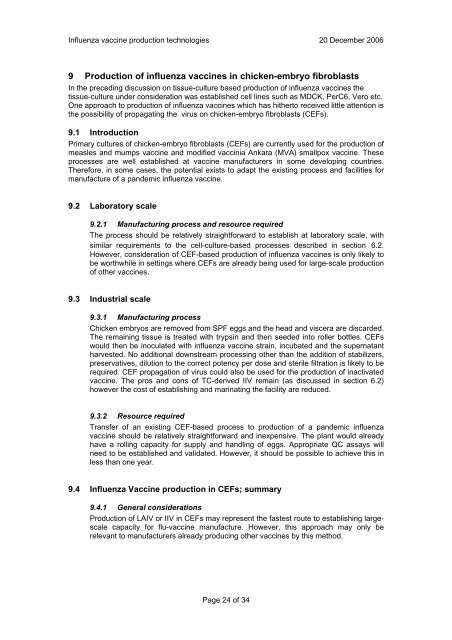A review of production technologies for ... - World Health Organization
A review of production technologies for ... - World Health Organization
A review of production technologies for ... - World Health Organization
Create successful ePaper yourself
Turn your PDF publications into a flip-book with our unique Google optimized e-Paper software.
Influenza vaccine <strong>production</strong> <strong>technologies</strong> 20 December 2006<br />
9 Production <strong>of</strong> influenza vaccines in chicken-embryo fibroblasts<br />
In the preceding discussion on tissue-culture based <strong>production</strong> <strong>of</strong> influenza vaccines the<br />
tissue-culture under consideration was established cell lines such as MDCK, PerC6, Vero etc.<br />
One approach to <strong>production</strong> <strong>of</strong> influenza vaccines which has hitherto received little attention is<br />
the possibility <strong>of</strong> propagating the virus on chicken-embryo fibroblasts (CEFs).<br />
9.1 Introduction<br />
Primary cultures <strong>of</strong> chicken-embryo fibroblasts (CEFs) are currently used <strong>for</strong> the <strong>production</strong> <strong>of</strong><br />
measles and mumps vaccine and modified vaccinia Ankara (MVA) smallpox vaccine. These<br />
processes are well established at vaccine manufacturers in some developing countries.<br />
There<strong>for</strong>e, in some cases, the potential exists to adapt the existing process and facilities <strong>for</strong><br />
manufacture <strong>of</strong> a pandemic influenza vaccine.<br />
9.2 Laboratory scale<br />
9.2.1 Manufacturing process and resource required<br />
The process should be relatively straight<strong>for</strong>ward to establish at laboratory scale, with<br />
similar requirements to the cell-culture-based processes described in section 6.2.<br />
However, consideration <strong>of</strong> CEF-based <strong>production</strong> <strong>of</strong> influenza vaccines is only likely to<br />
be worthwhile in settings where CEFs are already being used <strong>for</strong> large-scale <strong>production</strong><br />
<strong>of</strong> other vaccines.<br />
9.3 Industrial scale<br />
9.3.1 Manufacturing process<br />
Chicken embryos are removed from SPF eggs and the head and viscera are discarded.<br />
The remaining tissue is treated with trypsin and then seeded into roller bottles. CEFs<br />
would then be inoculated with influenza vaccine strain, incubated and the supernatant<br />
harvested. No additional downstream processing other than the addition <strong>of</strong> stabilizers,<br />
preservatives, dilution to the correct potency per dose and sterile filtration is likely to be<br />
required. CEF propagation <strong>of</strong> virus could also be used <strong>for</strong> the <strong>production</strong> <strong>of</strong> inactivated<br />
vaccine. The pros and cons <strong>of</strong> TC-derived IIV remain (as discussed in section 6.2)<br />
however the cost <strong>of</strong> establishing and marinating the facility are reduced.<br />
9.3.2 Resource required<br />
Transfer <strong>of</strong> an existing CEF-based process to <strong>production</strong> <strong>of</strong> a pandemic influenza<br />
vaccine should be relatively straight<strong>for</strong>ward and inexpensive. The plant would already<br />
have a rolling capacity <strong>for</strong> supply and handling <strong>of</strong> eggs. Appropriate QC assays will<br />
need to be established and validated. However, it should be possible to achieve this in<br />
less than one year.<br />
9.4 Influenza Vaccine <strong>production</strong> in CEFs; summary<br />
9.4.1 General considerations<br />
Production <strong>of</strong> LAIV or IIV in CEFs may represent the fastest route to establishing largescale<br />
capacity <strong>for</strong> flu-vaccine manufacture. However, this approach may only be<br />
relevant to manufacturers already producing other vaccines by this method.<br />
Page 24 <strong>of</strong> 34

















